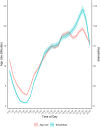Passively sensing smartphone use in teens with rates of use by sex and across operating systems
- PMID: 39097657
- PMCID: PMC11297944
- DOI: 10.1038/s41598-024-68467-8
Passively sensing smartphone use in teens with rates of use by sex and across operating systems
Abstract
Youth screen media activity is a growing concern, though few studies include objective usage data. Through the longitudinal, U.S.-based Adolescent Brain Cognitive Development (ABCD) Study, youth (mage = 14; n = 1415) self-reported their typical smartphone use and passively recorded three weeks of smartphone use via the ABCD-specific Effortless Assessment Research System (EARS) application. Here we describe and validate passively-sensed smartphone keyboard and app use measures, provide code to harmonize measures across operating systems, and describe trends in adolescent smartphone use. Keyboard and app-use measures were reliable and positively correlated with one another (r = 0.33) and with self-reported use (rs = 0.21-0.35). Participants recorded a mean of 5 h of daily smartphone use, which is two more hours than they self-reported. Further, females logged more smartphone use than males. Smartphone use was recorded at all hours, peaking on average from 8 to 10 PM and lowest from 3 to 5 AM. Social media and texting apps comprised nearly half of all use. Data are openly available to approved investigators ( https://nda.nih.gov/abcd/ ). Information herein can inform use of the ABCD dataset to longitudinally study health and neurodevelopmental correlates of adolescent smartphone use.
Keywords: Adolescents; Android; Passive sensing; Screen media activity; Screen time; Smartphone use; iOS.
© 2024. The Author(s).
Conflict of interest statement
N.B. Allen holds an equity interest in Ksana Health, which produces commercial licenses for the EARS software that was used in this manuscript. No other authors have any competing interests to disclose.
Figures



Similar articles
-
Passive Sensing of Preteens' Smartphone Use: An Adolescent Brain Cognitive Development (ABCD) Cohort Substudy.JMIR Ment Health. 2021 Oct 18;8(10):e29426. doi: 10.2196/29426. JMIR Ment Health. 2021. PMID: 34661541 Free PMC article.
-
Smartphone Screen Time Characteristics in People With Suicidal Thoughts: Retrospective Observational Data Analysis Study.JMIR Mhealth Uhealth. 2024 Oct 11;12:e57439. doi: 10.2196/57439. JMIR Mhealth Uhealth. 2024. PMID: 39392706 Free PMC article.
-
Adolescent smartphone use, sleep, and physical activity: daily associations between sensor-based measures in the adolescent brain cognitive development (ABCD) study.Psychiatry Res. 2025 Jul;349:116523. doi: 10.1016/j.psychres.2025.116523. Epub 2025 Apr 30. Psychiatry Res. 2025. PMID: 40319611
-
Content and Quality of Infant Feeding Smartphone Apps: Five-Year Update on a Systematic Search and Evaluation.JMIR Mhealth Uhealth. 2020 May 27;8(5):e17300. doi: 10.2196/17300. JMIR Mhealth Uhealth. 2020. PMID: 32459187 Free PMC article.
-
Smartphone Apps for Patients With Hematologic Malignancies: Systematic Review and Evaluation of Content.JMIR Mhealth Uhealth. 2022 Sep 20;10(9):e35851. doi: 10.2196/35851. JMIR Mhealth Uhealth. 2022. PMID: 36125860 Free PMC article.
Cited by
-
Association of digital screen use during recess with physical activity behaviours in 10-year-old to 17-year-old Danish adolescents: a population-based cross-sectional study.BMJ Public Health. 2025 Jan 16;3(1):e001150. doi: 10.1136/bmjph-2024-001150. eCollection 2025. BMJ Public Health. 2025. PMID: 40017946 Free PMC article.
-
What we know about screen time and social media in early adolescence: a review of findings from the Adolescent Brain Cognitive Development Study.Curr Opin Pediatr. 2025 Aug 1;37(4):357-364. doi: 10.1097/MOP.0000000000001462. Epub 2025 Apr 1. Curr Opin Pediatr. 2025. PMID: 40172268 Review.
-
Lifestyle Behaviors Associated with Weight Loss Intent in Adolescent Girls: Findings from the US 2021 National Youth Risk Behavior Survey.Nutrients. 2025 May 15;17(10):1676. doi: 10.3390/nu17101676. Nutrients. 2025. PMID: 40431416 Free PMC article.
-
Objectively Measured Smartphone Use and Nonsuicidal Self-Injury Among College Students: Cross-Sectional Study.JMIR Ment Health. 2025 Jul 30;12:e71264. doi: 10.2196/71264. JMIR Ment Health. 2025. PMID: 40737603 Free PMC article.
-
Mobile phone ownership, social media use, and substance use at ages 11-13 in the ABCD study.Addict Behav. 2025 Feb;161:108211. doi: 10.1016/j.addbeh.2024.108211. Epub 2024 Nov 6. Addict Behav. 2025. PMID: 39520899
References
-
- Rideout, V., Robb, M. B., Sense, T. C. & census: Media use by tweens and teens,. 2019 (Common Sense Media, 2019).
-
- Rideout, V. The common sense census: Media use by tweens and teens (2015).
MeSH terms
Grants and funding
- U24 DA041147/DA/NIDA NIH HHS/United States
- U01 DA051039/DA/NIDA NIH HHS/United States
- U01 DA041120/DA/NIDA NIH HHS/United States
- K08 DA050779/DA/NIDA NIH HHS/United States
- U01 DA051018/DA/NIDA NIH HHS/United States
- U01 DA041093/DA/NIDA NIH HHS/United States
- U24 DA041123/DA/NIDA NIH HHS/United States
- U01 DA051038/DA/NIDA NIH HHS/United States
- U01 DA051037/DA/NIDA NIH HHS/United States
- U01 DA051016/DA/NIDA NIH HHS/United States
- U01 DA041106/DA/NIDA NIH HHS/United States
- U01 DA041117/DA/NIDA NIH HHS/United States
- U01 DA041148/DA/NIDA NIH HHS/United States
- T32 DA050560/DA/NIDA NIH HHS/United States
- U01 DA041174/DA/NIDA NIH HHS/United States
- U01 DA041134/DA/NIDA NIH HHS/United States
- U01 DA041022/DA/NIDA NIH HHS/United States
- U01 DA041156/DA/NIDA NIH HHS/United States
- U01 DA050987/DA/NIDA NIH HHS/United States
- U01 DA041025/DA/NIDA NIH HHS/United States
- U01 DA050989/DA/NIDA NIH HHS/United States
- U01 DA041089/DA/NIDA NIH HHS/United States
- U01 DA050988/DA/NIDA NIH HHS/United States
- U01 DA041028/DA/NIDA NIH HHS/United States
- U01 DA041048/DA/NIDA NIH HHS/United States

